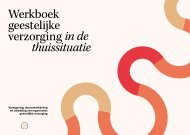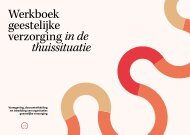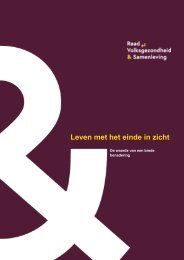Buiten kerk en moskee
Religie in een pluriforme samenleving. Diversiteit en verandering in beeld.
Religie in een pluriforme samenleving. Diversiteit en verandering in beeld.
Create successful ePaper yourself
Turn your PDF publications into a flip-book with our unique Google optimized e-Paper software.
three possible chall<strong>en</strong>ges (amongst others) at differ<strong>en</strong>t levels: at the level of the individual,<br />
at intergroup level (betwe<strong>en</strong> social groups) and at the level of society as a whole.<br />
1) A greater m<strong>en</strong>tal (exist<strong>en</strong>tial) stress on the individual, who will increasingly have to give<br />
meaning to their life themselves, if they are seeking meaningfulness.<br />
2) Ideological t<strong>en</strong>sions and cleavages betwe<strong>en</strong> the numerically dominant secular majority<br />
and believers, including a growing number of orthodox and other Muslims. These t<strong>en</strong>sions<br />
may manifest themselves in and be fed by increasing inequality, reduced repres<strong>en</strong>tation,<br />
mistrust and conflict.<br />
3) The disappearance of churches may be accompanied by a reduction in the number of<br />
volunteers.<br />
8.3.1 Religious diversity and social cohesion<br />
A common concern – throughout most of history – is the question of whether society is<br />
slowly but surely falling apart and becoming less and less a community of citiz<strong>en</strong>s who feel<br />
a connection with each other. Worst-case sc<strong>en</strong>ario, this will result in a disconnected whole<br />
of individuals and groups, each living in their own world, without any solidarity with each<br />
other. In public and academic debate, concerns are regularly expressed about possible<br />
cleavages and dichotomies. For example, betwe<strong>en</strong> rich and poor, the lower and higher<br />
educated, people who participate and those who stand on the sidelines, people with and<br />
without a migration background, but also betwe<strong>en</strong> people with differ<strong>en</strong>t ideological or<br />
religious positions (see Bov<strong>en</strong>s et al. 2014, for example). Where social cleavages are concerned,<br />
three dim<strong>en</strong>sions can be distinguished: differ<strong>en</strong>tiation, id<strong>en</strong>tification and repres<strong>en</strong>tation<br />
(Tiemeijer 2017). Differ<strong>en</strong>tiation refers to the ext<strong>en</strong>t to which differ<strong>en</strong>ces exist<br />
betwe<strong>en</strong> groups, id<strong>en</strong>tification is the ext<strong>en</strong>t to which people id<strong>en</strong>tify with one of the<br />
groups distinguished, while repres<strong>en</strong>tation relates to the ext<strong>en</strong>t to which the distinction<br />
betwe<strong>en</strong> these groups is also pres<strong>en</strong>ted as such politically and in the media. The higher a<br />
distinction betwe<strong>en</strong> groups ‘scores’ on these dim<strong>en</strong>sions, the more reason there is to<br />
speak of a cleavage. Others id<strong>en</strong>tify other dim<strong>en</strong>sions too, such as Deegan-Krause (2007),<br />
who names social structures, attitudes and institutions. Are there social contradictions and<br />
social groups that can clearly be distinguished from each other? Are there differ<strong>en</strong>ces in<br />
attitude, views and political prefer<strong>en</strong>ces betwe<strong>en</strong> the groups? Do the social groups organise<br />
themselves into separate social and political institutions? Associations and political<br />
parties, for example?<br />
In literature on the subject, it is assumed that the boundaries betwe<strong>en</strong> groups become<br />
more rigid the more a number of dim<strong>en</strong>sions of distance converge. For example, the consequ<strong>en</strong>ces<br />
of mutually reinforcing cleavages are more problematic for social cohesion than<br />
cross-cutting cleavages are (Bov<strong>en</strong>s et al. 2014). The stronger the accumulation, the deeper<br />
the cleavage and the greater the possible consequ<strong>en</strong>ces. Cleavages are regarded as undesirable<br />
for a number of reasons, one of which is the possibility for them to go hand in hand<br />
with inequality of opportunity, limited freedom, mistrust and conflict, the reduced repres<strong>en</strong>tation<br />
of certain groups and a society that is less cohesive (Tiemeijer 2017). In this sub-<br />
158 c o n c l u d i n g r e m a r k s o n t h r e e r e p o r t s










